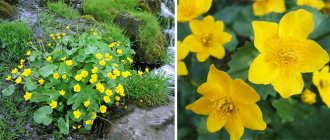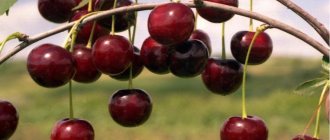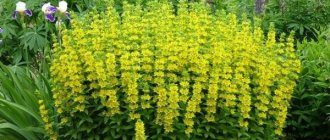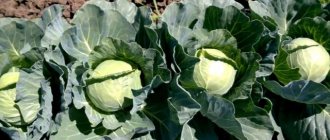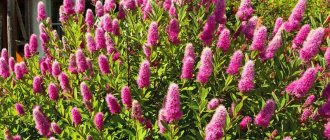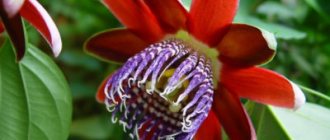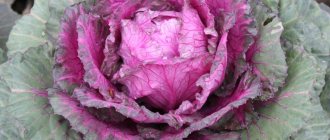Description of Arnold's hawthorn
The Arnold hawthorn shown in the photo is a tall tree, the height of which from the soil surface to the crown is about 6 m. The crop reaches this size at the age of 20-25 years. The crown is pyramidal in shape, has many shoots, the volume of the lower part is 4-4.5 m. The plant is deciduous, perennial, frost-resistant.
It blooms in May, flowers abundantly, fruits ripen in September. The yield is high; the crop produces berries in the fifth year of the growing season. It remains decorative from spring to late autumn. In early October, the leaves turn bright burgundy. The fruits remain on the tree after leaf fall and serve as food for birds in winter. Growth up to 4 years is insignificant, then the tree grows quickly, adding 35 cm in height and width.
External description of the Arnold hawthorn variety:
- The lower circle of skeletal branches grows horizontally, close to the ground surface. The formation of each subsequent one occurs with a decrease in the angle relative to the central trunk. The last branches are located at an angle of 450 to form a rounded crown.
- The bark is gray, rough, with chaotically located small furrows and large (up to 5 cm), woody spines.
- Young shoots are geniculate, thick, light green.
- The leaves are large (5 cm), lanceolate, smooth, shiny, opposite. The edges of the leaf blade are finely toothed, the surface has parallel veins. The cuttings are thin, flexible, long.
- The flowers are simple, large, white, with a sharp, specific odor.
Formation is single or up to 8 pieces on a branched fruit raceme.
- The berries are large, round, glossy, on the upper part there is a deep receptacle with uneven edges. The color is dark red with sparse, small white dots. The pulp has a dense consistency, light pink with two seeds.
- The fruits are sweet and sour, juicy, and have medicinal properties.
Botanical description
Most hawthorns are deciduous multi-stemmed trees, but there are also semi-evergreen plant species. Hawthorns reach a height of 3 to 5 m, but in optimal conditions they can grow up to 12 m. Their crown is round, dense, ovoid or spherical, often asymmetrical. The bark is gray or brown, fissured or ribbed, and in some species it peels off in small plates. Branches are straight, zigzag or weeping. Young shoots are with felt pubescence or bare, purple-red in color. The branches of many species are equipped with leafless spines ranging from 5 mm to 10 cm in length, developing from axillary buds. Asian and European species of hawthorn have small or no thorns.
Round, rhombic, elliptical or ovate leaves of hawthorn with a pinnately incised, whole or lobed blade with serrated, jagged or dissected edges are arranged on the shoots in a spiral. The leaves are from 1 to 12 cm in length, they can be glabrous or densely pubescent, petiolate or almost sessile. In the fall, the leaves of many species turn orange, purple, or gold, but some species keep their leaves green until they fall.
White, pink or red flowers of hawthorn with a diameter of 1-2 cm with five petals form complex corymbose or umbellate inflorescences. Sometimes they are multi-flowered, but in some species the flowers are single or collected in a bouquet of 2-3 pieces. The flowers contain dimethylamine, which gives them the smell of decaying fish. Hawthorn begins to bloom in spring or early summer.
- Goji: cultivation, properties, types
Hawthorn fruits are spherical, pear-shaped or elongated small apples ranging in size from 5 mm to 4 cm. Several large triangular seeds ripen inside the fruit. The color of the fruit depends on the type and variety of the plant: they can be red, bright orange, orange-yellow and almost black. The fruits ripen in September or October. Hawthorn reaches maximum fruiting by the age of 10 years.
We will tell you how to plant and care for hawthorn in open ground: when and how to plant the plant, how and when hawthorn blooms, how to protect it from diseases and pests, when you can replant hawthorn, what types of hawthorn can be grown in cultivation, in what the benefits of hawthorn and who it can harm.
Arnold's hawthorn in landscape design
Arnold's hawthorn and its varieties are classified as ornamental trees and shrubs. The crop responds well to formative pruning and retains its shape for a long time. In spring it blooms profusely, the crown turns completely white, looks bright during fruiting and the autumn change of leaf color.
The culture is used to decorate park areas, gardens, and private plots. Landscape design techniques using tall crop species do not depend on the crop variety. Below are several examples of the possible use of Arnold's hawthorn in ornamental gardening.
Multifunctional hedge. The seedlings are distributed in one line to separate zones of the territory; the presence of thorns will protect the area from the penetration of animals.
The lower branches are cut off, given a classic tree shape, and planted in a group to decorate the front lawn in front of the building.
As a tapeworm in the center of the lawn.
In a group composition with ornamental shrubs.
For decoration of edges in city parks.
Dense planting of hawthorn along the edges of the path will visually create a labyrinth.
Planting and caring for Arnold's hawthorn
The crop is undemanding to soil composition, has high drought resistance, and is very winter-hardy. The Arnold variety does not tolerate darkening. Arnold's common hawthorn takes root well, and at an older age it calmly reacts to transfer.
Landing dates
Arnold's hawthorn is the leader among biological species in terms of frost resistance; it is not afraid of spring frosts. The seedlings of the crop are not inferior to an adult tree in terms of frost resistance, so seedlings are planted in the spring, when the ground has completely thawed, and in the fall, 1.5 months before frost.
Selection and preparation of a landing site
A well-ventilated, completely open area is allocated for hawthorn. Suitable soil is sandy loam or loamy, the composition does not matter, the only condition is not saline. The planting hole is prepared in advance; if there is a single planting, they dig a hole with a diameter and depth of 60 cm. If two or more seedlings are planted, the holes are placed at a distance of 2 m from each other. To create a hedge, the plant is planted in a trench 60 cm wide, 50 cm deep, and the distance between seedlings is 45 cm.
Landing rules
The root of the seedling is dipped into a growth stimulating drug for several hours. Make a thick clay solution into which the roots are placed before planting. Sequence of planting work:
- Pour 2 buckets of compost and 5 tbsp into the bottom of the hole. l. nitrophoska, pour 1.5 buckets of organic matter and 4 tbsp into a 1 m trench. l. nitrophoska.
- The young tree is placed in the center.
- They are covered with soil, watered, the tree trunk circle is covered with sawdust or peat, the root collar is not deepened.
Watering and fertilizing
Arnold's hawthorn does not require watering; it only needs rainfall once a month. During drought, the plant is watered with the same frequency, using at least 10 liters of water for each seedling. Before fruiting, the young tree is fed 2 times. In the spring (before the leaves bloom) urea is added, and in the fall they are fed with nitrophoska. After the first fruiting and in subsequent years, add 1 additional fertilizer during the flowering period, using Agricola.
Read also Cabbage with beets, marinated in large pieces
Trimming
Densely planted Arnold's hawthorn can be given all sorts of shapes; the plant produces shoots quickly, and the crown calmly responds to shaping. The haircut is carried out in the fall (after picking berries). In the spring, the Arnold hawthorn is sanitized and dry branches are cut off.
Wintering
Arnold's hawthorn seedlings and adult plants resist frosts down to -380 C, so the trees do not need to cover their crowns. For successful formation of fruit buds in spring and autumn, the plant is watered with plenty of water. I double the mulch layer. Use sawdust, peat, wood chips or straw.
Landing at a permanent place
Plant garden hawthorn in a sunny place. Planting in shade or partial shade does not allow it to fully develop. Lack of sun reduces yields, and sometimes there are no fruits at all. The soil should be fertile and moderately heavy. Acidic soils must be limed. Planting is done in pre-dug holes, 60x60 cm in size, of the same depth. When planting in groups, the distance between trees is left at least 4 meters. To create a hedge, plant them often, 50 cm apart. When planting, the root collar should remain strictly at ground level.
Reproduction
Arnold's hawthorn propagates vegetatively and by seeds, but due to the peculiar structure of the seeds, the generative method of hawthorn propagation is not used on the site. The hard outer shell inhibits seed germination. Shoots may appear only in 2-3 years. This hawthorn will enter the flowering phase in the 8th year of the growing season.
Arnold's common hawthorn is independently bred only by vegetative means:
- The tree produces root shoots, which are used for propagation.
- An effective method is cuttings. The material is cut in the spring from the top of last year's shoots.
- The fastest breeding method is spring grafting or July budding.
Applications of Arnold's hawthorn
Due to its chemical composition, hawthorn is used in traditional medicine: for the treatment of cardiovascular pathologies, as a sedative. In folk recipes, the plant is used to treat insomnia; tinctures act as a diuretic.
Arnold's hawthorn is consumed fresh; the berries retain their active substances after freezing. The fruits and young thin shoots are dried and added to tea. Dry berries are ground into powder and added to flour for baking. Juice, jam, jam are made from the fruits.
Arnold's hawthorn: description and features
The plant's homeland is the eastern part of North America, where it lives in overgrown places in the lowlands of rivers. The tree grows tall, from 6 to 8 m, with a wide, rounded crown with a diameter of about 6 m, has thin and shiny shoots, as well as large spines - up to 9 cm long. The leaves of Arnold's hawthorn are oval and wide, divided into three lobes, and have an interesting feature - at different times of the year they have a different appearance:
- in spring and summer – light green, bright;
- in autumn they turn yellow-red.
The tree blooms with large white flowers with a characteristic aroma, which many find unpleasant. The active flowering time occurs in late spring or early summer, after which large berries appear in place of the inflorescences (the fruits are larger than those of other varieties of hawthorn). The pulp is juicy, contains a large amount of vitamins and is suitable for any purpose - drying, freezing, canning. Productivity is about 4-6 buckets of fruit from one adult plant.
For decorative purposes, Arnold's hawthorn is used primarily to create hedges, but it is better to plant it away from fruit trees. The disadvantage of the plant is that it often becomes a home for parasites and harmful insects, which can spread to neighbors. This is especially true for garden plots where there are apple trees - the crops have common pests, so it is better to plant them in different places.
Types of hawthorn
When choosing hawthorn for planting in the garden, you should pay attention to the most unpretentious species with large fruits and high yields: pinnathorn, softish and American Arnold.
The only requirement: planting should be done in places well lit by the sun; groundwater should not pass close to the surface. Maintenance is minimal; these garden trees do not require much attention.
Soft hawthorn grows in the form of a tree with a height of 6 to 10 meters. The crown naturally forms in the form of a rounded tent. The shoots are twisting, covered with long spines, 6-8 cm in size. The spines are shiny brown and can be straight or curved. The leaves are ovoid, 3-4 cm wide and 3 to 7 cm long. The leaf edge is serrated. Care is not difficult, fruiting begins 6 years after planting. The fruits are large, up to 2 cm in diameter, orange-red in color. Their shape is round or pear-shaped. The pulp is mealy, yellow in color, and tastes pleasant.
How to plant
Caring for Arnold's hawthorn is very simple, but the planting process can present some difficulties. Tree cuttings root weakly, so the seed propagation method is preferable, which requires time and patience. The seed material has a hard shell, so without additional processing it germinates only after 1.5-2 years. For normal growth and development, the plant requires the following conditions:
- sunny, maybe an open place (hawthorn can grow in the shade, but it will bear fruit and bloom poorly);
- optimal soil characteristics are sandy or loam, with good drainage, slightly acidic or slightly alkaline reaction.
Otherwise, there are no special requirements for the planting site - it tolerates wind and frost well, and can grow on heavy and clay soils.
Sowing seeds
You can buy the seeds in the store or take out the unripe fruits, put them in water for two days, remove the pulp well and rinse. They retain germination for 2 years, but not all of the seed material germinates, so it is better to sow them densely, and after germination, choose the strongest and strongest. There are two ways to plant Arnold's hawthorn - before winter or in spring, and the first option does not require additional measures, and in the second case, the seeds must be prepared in advance. The seeds are stratified in sand at a temperature of about 20-25 degrees for about 2 months, after which the temperature is reduced to 4-7 degrees and kept for another 4-6 months.
Read also How to make pancakes with yeast
Propagation by cuttings
Cuttings for planting Arnold's hawthorn are cut from young shoots in early spring or autumn, after the leaves have fallen. They are kept in a root-forming preparation for an hour, after which they are planted in open soil. Drainage should be poured into the planting hole, a mixture of humus, peat and sand, 30-40 g of lime or 50 g of phosphate rock should be added. The prepared cuttings are planted in the hole, covered with soil and compacted well - after the soil settles, the root collar should be flush with its surface. After planting, mulch the soil around with a 5-7 cm layer of peat.
It is better to cover the planted cuttings from above with a plastic bottle to create greenhouse conditions favorable for growth. In the first year, young plants develop poorly, but with proper care and favorable conditions they gain good growth - 25-30 cm per year.
Hawthorn propagation
Garden hawthorn is propagated in two ways: by seeds and vegetatively.
How to grow hawthorn from seeds
This is a more labor-intensive method that will require patience and proper care of the young seedlings. Hawthorn seeds are covered with a dense peel and a thick protective layer. This complicates gas permeability, and therefore the embryo is in a state of deep dormancy. The awakening process lasts about 2-3 years, seedlings appear unevenly. Large seeds may not germinate at all. Stratification helps speed up germination. To do this, the seeds are mixed with peat. They are kept in a damp state for 4 months at a temperature of 20 – 25°C, then put in a cool place for 6-7 months. The temperature must be maintained between 4° and 7°. After stratification, they are again brought into the heat.
If, instead of a peat mixture, planting is carried out in sand, the awakening period increases by 1-2 months. There are several ways to shorten the process:
- the seed is washed in a large amount of running water and then dried at a temperature of about 50°C;
- to soften and destroy the hard shell, soak in hydrochloric acid for 20 minutes;
- cut off the top of the bone with a sharp pruner;
- seeds are taken from large unripe fruits, when the shell has not yet hardened.
For sowing, you should take two to three times more seeds than necessary. Some planting material is often sterile.
Vegetative propagation
When an old tree is cut down, dormant buds awaken, from which many shoots grow. Shoots that have grown their own roots are excellent planting material. She takes root well and retains all her maternal properties. Planting green cuttings is less effective: rooting is difficult and survival rate is minimal.
Arnold's hawthorn care
Arnold's hawthorn has a feature that the gardener needs to remember - unlike other varieties of the crop, it needs to be watered even with normal rainfall. The frequency of watering is once a month, 1-1.5 buckets of water for each bush, and on dry days it is necessary to water the plants twice a month.
The ground around the tree should be regularly loosened by about 10 cm, weeds should be removed, and in spring and autumn the tree trunk circle should be dug up using a spade bayonet. A crust should not form on the surface of the soil, but you should not over-moisten the soil either, otherwise the hawthorn will get sick.
The plant responds well to pruning - in the spring you need to remove all dry, frozen and diseased branches. In addition, it can be given the desired shape by cutting off no more than 1/3 of the length of the shoot. Arnold's hawthorn needs to be fed at least twice a season - in the spring with long-acting granular mixtures, and before the flowers appear - with organic fertilizers (liquid mullein).
Trees tolerate low temperatures well, but in the first 2-3 years it is recommended to protect them from frost. With age, the winter hardiness of the crop increases, and the hawthorn will not need shelter. At the first signs of disease and pest damage, the plant must be treated with special preparations, otherwise it may die.
Aftercare
In order for Arnold's large-fruited hawthorn to grow and develop beautifully and delight its owner with a rich harvest, it is important to properly care for it.
- Watering. Hawthorn should be watered once a month at the rate of 15 liters of water per tree. Younger plants need to be watered a little more often, especially in dry summers. If the summer is rainy enough, then watering is not required at all.
- Feeding. To get a rich harvest, you need to take care of good feeding. Every spring he plans to add nitroammophoska. Before flowering, a bucket of liquid mullein is applied under each tree to feed it.
- Trimming. There are two types of pruning: sanitary and formative. Sanitary pruning is carried out annually. Its goal is to remove all diseased, dried, and frozen branches. When formative pruning, you should not trim more than 1/3 of the length of the shoot. If you cut more, the plant will not be able to bloom and bear fruit normally.
- Preparing for winter. The plant is considered frost-resistant, and therefore does not require special preparation. It is enough to mulch the root zone with straw or hay.
Diseases and pests, control methods and prevention
For Arnold hawthorn, the description of the variety lists several diseases to which the tree is susceptible.
- Rust. If suspicious spots are detected, diseased shoots must be pruned immediately to avoid the spread of infection.
- Powdery mildew - Spraying with modern fungicides is required.
In addition to diseases, hawthorn is susceptible to attack by pests. As a preventive measure, a soap solution helps against them, as well as a tobacco solution, which is supposed to be sprayed on the tree a couple of times a season.
After flowering, you can spray the tree again if the infestation is too severe.
Let's summarize
- Arnold's hawthorn is a beautiful plant with tasty and healthy fruits that will decorate any garden plot.
- Bushes should be planted in sunny places away from fruit trees, especially apple trees, as they suffer from the same diseases.
- Arnold's hawthorn does not require special care, but, unlike other varieties of crops, it needs to be watered 1-2 times a month, depending on the amount of precipitation.
- The most difficult period in growing a plant is planting and the first year of growth, but in the future it will not cause much trouble to the gardener.
Beneficial properties of hawthorn
The beneficial properties of hawthorn are due to its chemical composition: the main active ingredients in hawthorn are flavonoids, the number of which reaches 17. They have a vasodilating effect on the blood vessels of the heart, and the absorption of oxygen by the heart muscle is significantly improved. Under the influence of hawthorn, the heart muscle begins to contract stronger and less frequently. In addition, hawthorn lowers blood pressure and has a slight calming effect.
A fairly large amount of tannins was found in the fruits of hawthorn, which makes it possible to use it for diarrhea and dysentery as an astringent and fixative. Hawthorn seeds contain from 27.5 to 33.2% fatty oil.
Hawthorns are rich in pectin substances. It is known that in addition to the gelling ability, pectin substances bind heavy metals (strontium, cobalt, etc.), and since these compounds are not digested, they are removed from the body. The total content of pectin substances in hawthorn fruits is 1.9-6.1% by fresh weight of the pulp.
Hawthorn fruits are rich in microelements (Cu, Fe, Zn, Mo, Mg, Co). The amount of microelements in hawthorn fruits is at the level of cultivated fruit and berry plants, and in some indicators they are superior to them.
The fruits of most types of hawthorn have not only medicinal but also nutritional value. Hawthorn fruits, especially those with mealy pulp, were used dried for food. They were ground into flour, which was added to regular flour when baking bread and confectionery. They have a fairly high sugar content, depending on the type it reaches from 4 to 11%, and the main sugar is not glucose or sucrose, but fructose, so they can be safely eaten if you have diabetes. The malic acid content ranges from 0.26 to 0.93%. In juicier fruits it is higher; mealy, dryish fruits are almost devoid of acids. The content of pectin in hawthorn is quite high, which not only forms jelly during fruit processing, but also removes heavy metal salts and other harmful substances from the body. The vitamin content also varies depending on the type of hawthorn. In milligrams per 100 g of berries, their content reaches: vitamin C - 31-108 (in American species up to 257.3), vitamin P - 330-680, carotene 2-4 (up to 75 in American species).
Reviews
“I was given several cuttings of Arnold’s hawthorn for the occasion. In the spring, I planted them on the plot and was surprised - the seedlings quickly took root and began to bear fruit with berries the size of cherries. The fruits are very tasty, and there are practically no seeds in them - you can eat them fresh, make jam and even make wine.”
“Arnold's hawthorn is an ideal option for those who grow a tree for its harvest. You have to wait several years for fruiting, but the berries are large, with excellent taste, without unnecessary sweetness or acidity. When propagated by seeds, it retains its characteristics, so it is excellent for nurseries.”
Arnold's hawthorn is a plant variety native to America, but it also thrives in Siberia. Many people call hawthorn “thorn”, since this is really one of its main parts. During flowering, the shrubs have a very beautiful decorative appearance. However, their main value lies elsewhere - the fruits contain a large amount of vitamins, which give the berries some medicinal properties.
Description of the plant
Arnold's hawthorn has some important differences from other varieties of this plant, namely:
- large crown sizes - ornamental trees reach a height of 6 meters;
- large edible fruits reach three centimeters in diameter, have orange tints, the flesh is juicy, pinkish in color, not mealy, sweet and sour in taste; each berry contains 3-4 seeds;
- rich chemical composition of the fruit - the berries contain a large amount of vitamin C and carotene.
The trees bloom at the end of May, and the berries ripen in the first half of September. Trees begin to produce crops approximately 5 years after planting. The fruit yield is usually quite high - an adult plant produces up to 6 buckets of large fruits. They can be eaten fresh, as well as prepared for the winter - jam, wine, compotes, or brewed as tea.
It is important to remember that you cannot eat too many hawthorn fruits - you can eat no more than 1 cup of berries at a time. Excessive consumption of hawthorn fruit can greatly lower blood pressure and disrupt heart rhythm.
Arnold's hawthorn, like all other varieties of large-fruited hawthorn, has powerful long spines that reach a length of 9-10 cm.
Read also How to paint polyurethane foam outside
Characteristics of the variety
The main advantage of this variety is its unpretentiousness. In addition, Arnold's hawthorn is considered durable. His age reaches 120 years. The variety is used not only as single plantings, but also for hedges, as well as decorative group plantings.
Drought and frost resistance
The tree is drought-resistant and can tolerate frost. As for watering, it is enough to water the bush 2 times a month. In too dry summers, the frequency of watering can be increased up to three times.
The plant is also frost-resistant, which allows it to be grown in almost all climatic zones. It is necessary to insulate for the winter only in northern regions, where sub-zero temperatures below 40 degrees remain for a long time.
Productivity and fruiting
The berries of this variety ripen in early September. The first yield occurs approximately 5 years after planting. An adult tree, with proper agricultural technology, produces 6 buckets of hawthorn fruits per season. The berries reach three cm in diameter and have several seeds.
Resistance to diseases and pests
Arnold's hawthorn requires protection from pests and diseases. The most common diseases to which these plants are susceptible:
- Powdery mildew - is expressed in the appearance of a white or gray coating on the leaves. As a result, the leaves curl. For treatment, double treatment with known fungicides is used.
- Buff spot is a common disease that causes leaves to dry out and fall off early.
- Brown spot also destroys leaves.
When the first symptoms of any disease appear, the plant must be treated with a fungicide.
The most dangerous pests for Arnold's hawthorn are aphids, scale insects, leaf rollers and hawthorns.
Advantages and disadvantages of the variety
Arnold's hawthorn is noticeable with its luxurious crown. This tree can reach 6 meters in height. In addition, it has a number of other advantages:
- larger fruits;
- easy to care for;
- long-lived;
- several methods of reproduction;
- resistant to frost and drought;
- Suitable for use in landscape design.
But the large-fruited variety also has its disadvantages:
- long spines up to 9 cm;
- susceptible to many diseases;
- The first harvest is only in 5 years.
Planting and care
Arnold's hawthorn can be safely called an unpretentious plant. Only in rare cases can it be affected by fungal diseases - the leaves become covered with a gray coating. This can happen if the plant was planted in a shady place with a high level of dampness.
If you plan to grow hawthorn from seeds, be prepared for the fact that for the first few years it will grow very slowly, but after reaching four to five years of age, its growth rate becomes much faster. Trees begin to bloom for the first time only 5-8 years after planting. If you want to get a fruit-bearing tree in a shorter period of time, grow hawthorn by grafting. Such plants begin to bloom after 3-4 years.
Trees reach their maximum size at the age of approximately 25 years. Each tree can live more than 200 years under favorable conditions.
To speed up the process of seed germination, you can use seeds from semi-ripe fruits. The berries should already begin to acquire the characteristic shade of ripening, but should still remain firm. Also, when selecting plant seeds for sowing, you need to take into account that almost half of them end up without seeds inside.
Hawthorn can also be propagated vegetatively. Trees often send out young shoots - these root shoots can be planted and propagated using this method. Another method of plant propagation is cuttings, which is carried out in the same way as with all other fruit and berry plants.
Hawthorn bushes should be planted in exactly the same planting holes as seedlings of fruit trees (apple tree, pear tree and others) - the distance between the trees should be at least four meters. This plant loves sunny places, but in shady areas the hawthorn can get sick, bloom poorly and not bear fruit.
Hawthorn trees do not require too much watering; 1-2 buckets per plant once a month will be enough. During particularly hot and dry periods, watering can be increased up to twice a month.
Plants tolerate pruning very well, quickly forming new shoots, so it is possible to give trees interesting shapes - for example, a cube or a ball. In this way you can add an interesting and unusual touch to the design of the site.
It is best to fertilize hawthorn in the spring - before the trees begin to bloom. It is best to use manure soot for these purposes.
Where is it used?
Often, hawthorn is grown not only for the purpose of obtaining healthy and very tasty fruits, because hawthorn bushes can also be used as a living thorny hedge. This plant has a very attractive decorative appearance, especially in autumn, so hawthorn will definitely decorate the site.
Properties
As already mentioned, hawthorn fruits contain many useful substances and vitamins - vitamin C and carotene, as well as fructose (which allows diabetics to consume hawthorn) and pectin (removes harmful heavy metal salts from the body).
Hawthorn leaves also have beneficial properties, a decoction of which improves coronary circulation, as well as the functioning of the heart muscle. That is why hawthorn is often recommended for use by older people, unless there are contraindications for use from the attending physician.
Hawthorn is no less useful for young people, especially in situations where the heart endures additional stress due to serious illnesses and stress.
Hawthorn berries are also effective in treating the biliary tract and liver. In addition, they normalize the functions of the thyroid gland and eliminate shortness of breath.
Please also note some contraindications to the use of hawthorn berries - it should not be used for the following diseases and conditions:
- hypotension;
- bradycardia;
- increased blood clotting;
- pregnancy and lactation period.
Useful and healing properties
Hawthorn flowers and leaves have healing properties. They are used to make tinctures and dried for tea. The fruits contain many vitamins, which are also preserved in dried berries. Hawthorn is useful for vegetative-vascular dystonia, mild disorders of the heart, strengthens blood vessels, and has calming properties. But, it can be used as a medicine only after consulting a doctor. But as a vitamin tea that improves performance, normalizes blood pressure, and saves from insomnia, you can drink it every day. Leaves and flowers are collected in spring to make tea. Flowers are most useful when they have not fully bloomed. Dry them in the shade, in a warm, ventilated room, spreading them out in a thin layer. From time to time you should stir it slightly. Store in glass jars, the lid must be closed. In autumn the fruits are dried. More valuable substances are preserved when dried in an oven at a minimum temperature, or in a special dryer for vegetables and fruits. Hawthorn tea can be prepared with the addition of other herbs and fruits. Ivan tea, dried raspberries, rose hips, mint, lemon balm, thyme - there are many options. Experiment and look for your own option.
The only rule when preparing tea is that the dry mixture should not exceed 1/5 of the volume of the teapot. Exceeding the norm can be harmful to health.
There are many benefits in frozen hawthorn. It is slightly defrosted and twisted in a meat grinder along with lemon. Then add a little honey - you get a vitamin mixture. To use, dilute 2 teaspoons in warm water and drink at any time.
Healthy jam
One of the best and most convenient recipes to prepare is hawthorn jam combined with other berries, prepared in a slow cooker. This recipe always receives only positive reviews on the Internet.
For preparation you will need:
- hawthorn berries – 1 kg;
- sugar – 1 kg;
- raspberries – 300 g;
- blueberries – 200 g;
- red currant juice – 250 ml.
In the multicooker, you need to turn on the mode for frying vegetables and prepare the syrup - to do this, add sugar to the currant juice. You need to add all the berries to the resulting syrup, and after they boil, remove the foam and cover with a lid. After 5 minutes, you can turn off the multicooker, but leave the jam to simmer under the lid for another hour. After this, the finished jam can be poured into jars and rolled up.
To learn how to make hawthorn jam, watch the following video.
